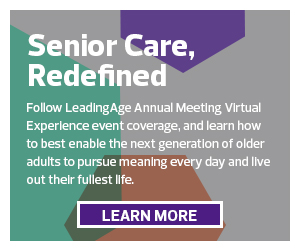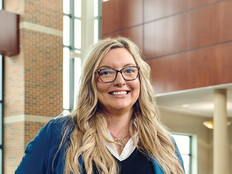Several weeks later, the applications have proved to be diverse: Virtual bingo games, online church services and videos on fitness and crafting are among the popular options.
Still, “the No. 1 thing people want to learn how to do is Zoom calls,” Andes said. “After being isolated for months and months, they’re looking for that in-person connection.”
With a long winter ahead and social distancing measures set to continue, senior care providers must evaluate, test and deploy diverse technologies for older adults to communicate with the outside world — and with each other.
LeadingAge speakers addressed that need during several sessions last week.
Smart Tools Bring Comfort and Independence to Senior Care
Although one-third of people 65 and older do not use the internet, according to the Pew Research Center, technology isn’t frightening to many seniors.
In fact, consumers over 50 are helping fuel the demand for smart home technology, an AARP survey found in January — and half of respondents said they would prefer to have their healthcare needs managed by a mix of medical staff and healthcare technology.
#LeadingAge20 attendees: What’s driving your 2021 #technology plans for #seniorcare?
— HealthTech Magazine (@HealthTechMag) November 10, 2020
At Cypress Village in Jacksonville, Fla., an infusion of tablets loaded with iN2L digital engagement software has reinvigorated residents and staff during lockdown. By playing games, using video chat and enjoying immersive experiences, residents with dementia and Alzheimer’s disease can be engaged while keeping their distance from others.
“We have seen the use of the tablets potentially reduce the risk of falls and the need for medication by stimulating these residents,” Ty Morgan, the community’s executive director, said during a LeadingAge session. “It has created more productive staff interaction, and residents can easily interact with family and friends daily.”
Technology may also be used to encourage residents to socialize with each other — and to get their bodies moving.
Teams at one senior care community provided Fitbit wearables as part of a challenge that encouraged residents to collectively walk the length of Route 66.
“Residents loved it so much they also ended up walking [the equivalent of] the coast of California,” Kelly Keefe, vice president of community solutions strategy at MatrixCare, a maker of software for skilled nursing faculties, noted in another session. “We don’t have to spend a fortune to engage with our residents. Think simply and think broadly.”
That notion guided a deployment of 600 Amazon smart speakers at Friendship Senior Options in Schaumburg, Ill. Residents with low vision or limited mobility can easily use the voice-activated Alexa platform, said Stephen Yenchek, the community’s president and CEO, who cited the growing value of natural language processing in healthcare.













